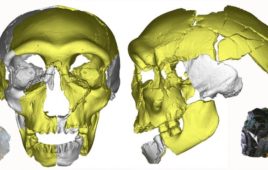 In 2003, archaeologists working on the Indonesian island Flores came across a startling discovery. In the limestone cave of Liang Bua, researchers found the skeletal remains of two humans. But these weren’t Homo sapiens. The bodies and brains were too small. According to the Atlas Obscura, Homo floresiensis stood less than four feet tall and their brains were between one-third and one-half the size of a Homo sapien. Despite that fact, evidence indicates that they used stone tools and may have used fire. Initially, researchers pegged the species as living alongside humans as little as 12,000 years ago.
In 2003, archaeologists working on the Indonesian island Flores came across a startling discovery. In the limestone cave of Liang Bua, researchers found the skeletal remains of two humans. But these weren’t Homo sapiens. The bodies and brains were too small. According to the Atlas Obscura, Homo floresiensis stood less than four feet tall and their brains were between one-third and one-half the size of a Homo sapien. Despite that fact, evidence indicates that they used stone tools and may have used fire. Initially, researchers pegged the species as living alongside humans as little as 12,000 years ago.
A new study about the Indonesian “Hobbits,” as they were popularly referred to by the media, published in Nature March 30 is refuting those claims. The study involved an international team of researchers.
“In fact, Homo floresiensis seems to have disappeared soon after our species reached Flores, suggesting it was us who drove them to extinction,” said study co-author Maxime Aubert, of Griffith University’s Research Centre of Human Evolution, in a statement.
According to the new research, the skeletal remains were dated to between 60,000 and 100,000 years ago. Stone artifacts attributed to the species were dated to between 50,000 and 190,000 years ago. The researchers, according to Griffith University, measured the skeletal remains’ amount of uranium and thorium to test the age.
“At the time of the initial discovery, not enough of the older deposits had been exposed, and this led to an error in the interpretation of how the dates obtained at the time applied to the sediments that contained the hobbit remains,” study co-author Matthew Tocheri, of Lakehead University, told National Geographic.
While the species remains shrouded in mystery, researchers can infer some things. Evidence indicates that Homo floresiensis extensively hunted Stegodon, an extinct type of elephant. According to Smithsonian National Museum of Natural History, myriads of elephant remains have been found near the ancient humans, some bones even showing signs of butchering.
Adam Brumm, an archaeologist with Griffith University’s Research Centre of Human Evolution, said the ancient Flores humans likely went the way of the Neanderthal. It’s likely that Homo sapiens replaced them, and came out evolutionarily on top.
R&D 100 AWARD ENTRIES NOW OPEN:
Establish your company as a technology leader! For more than 50 years, the R&D 100 Awards have showcased new products of technological significance. You can join this exclusive community! Learn more.




